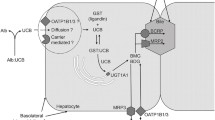Summary
Hepatic uptake and elimination of14C-bilirubin were studied after intravenous injection in 15 patients hospitalised with liver cirrhosis. Compared to 15 normal subjects, a significantly longer half-time of bilirubin uptake and conjugation and larger pools of plasma bilirubin and total bilirubin were observed.—There is a significant correlation between the half-time of bilirubin conjugation H2 and unconjugated serum bilirubin, total serum bilirubin, plasma and total bilirubin pools, serum protein and absolute serum gammaglobulin. Positive correlations exist also between unconjugated serum bilirubin, total serum bilirubin, unconjugated plasma bilirubin pool and total bilirubin pool.
Zusammenfassung
Bei 15 histomorphologisch gesicherten (klinisch behandelten) Lebercirrhotikern wurde unter gleichbleibenden stationär-klinischen Behandlungsbedingungen die hepatische Aufnahme und Konjugation von intravenös verabreichtem14C-Bilirubin gemessen. Im Vergleich zu einem Normalkollektiv (n=15) zeigte sich eine hochsignifikante Verlängerung der Halbwertszeit der Bilirubinaufnahme H1 und Konjugation H2 sowie eine Erhöhung des Plasma- und Gesamtbilirubinpools. Die Halbwertszeit H2 der Bilirubinkonjugation zeigt eine statistisch gesicherte positive Korrelation zum nichtkonjugierten Bilirubin, Gesamtbilirubin, Plasmabilirubinpool, Gesamtbilirubinpool, Serumgesamteiweiß und zur absoluten Serumgammaglobulinkonzentration; es bestehen auch positive Korrelationen zwischen unkonjugiertem Serumbilirubin, Gesamtserumbilirubin, unkonjugiertem Plasmabilirubin-und unkonjugiertem Gesamtbilirubinpool.
Similar content being viewed by others
Literatur
Billing, B. H., Williams, R., Richards, T. G.: Defects in hepatic transport of bilirubin in congenital hyperbilirubinaemia: An analysis of plasma disappearance curves. Clin. Sci.27, 245 (1954).
Gray, C. H., Kulczycka, A., Manfield, P., Nicholson, D. C.: The metabolism of14C-bilirubin in congenital nonhaemolytic hyperbilirubinaemia. Clin. Sci.27, 163 (1964).
Bouchier, J. A. D., Billing, B. H.: Bilirubin metabolism. Oxford and Edinburgh: Blackwell Sci. Pub. 1967.
Cameron, J. L., Filler, R. M., Iber, F. L., Abel, T., Randolph, J. G.: Metabolism and excretion of C14-labeled bilirubin in children with bilary atresia. New Engl. J. Med.274, 231 (1966).
Eilbott, W.: Bilirubin loading as a test of liver function. Z. klin. Med.106, 529 (1936).
Eisenburg, J.: Pathogenese und Klinik der Hyperbilirubinämie. Fortschr. Med.87, 441–448 (1969).
El-Barkawi, F. E.: Totalsynthese und radioaktive Markierung von Bilirubin IXα. Diss. Chem. Univ. Heidelberg 1968.
Hoppe-Seyler/Thierfelder: Handbuch der Physiologisch- und Pathologisch-chemischen Analyse, 10. Aufl., Bd. IV/2 und Band V. Berlin-Göttingen-Heidelberg: Springer 1960.
Kelly, R. G., Peets, E. A., Gordon, S., Buyske, D. A.: Determination of14C and3H in biological samples by Schöninger combustion and liquid scintillation techniques. Analyt. Biochem.2, 267 (1961).
Lester, R., Schmidt, R.: Intestinal absorption of bile pigments. II. Bilirubin absorption in man. New Engl. J. Med.269, 178 (1963).
Schmidt, M., Stich, W.: Die Elimination von14C-Bilirubin aus dem Serum von gesunden Menschen. Klin. Wschr.48, 221 (1970).
—— Eisenburg, J.: Ikterus-Diagnostik mit Isotopen. Über die klinisch-diagnostische Anwendung von14C-Bilirubin bei Erkrankungen der Leber. Fortschr. Med.87, 452 (1969).
Schmid, R., Hammaker, L.: Metabolism and disposition of14C-bilirubin in congenital nonhaemolytic jaundice. J. clin. Invest.42, 11 (1963).
With, T. K.: The bilirubin excretion test as a functional liver test with remarks on the course of the course of the curve of serum bilirubin. Acta med. scand.116, 96 (1934).
Author information
Authors and Affiliations
Additional information
Herrn Prof. Dr. H. Schwiegk zum 65. Geburtstag gewidmet.
Studie im Rahmen der Assoziation Hämatologie-EURATOM-GSF Nr. 031-64-1 BIAD.
Rights and permissions
About this article
Cite this article
Schmidt, M., Eisenburg, J. & Stich, W. Die14C-Bilirubinclearance bei Lebercirrhose. Klin Wochenschr 49, 345–348 (1971). https://doi.org/10.1007/BF01496456
Issue Date:
DOI: https://doi.org/10.1007/BF01496456




